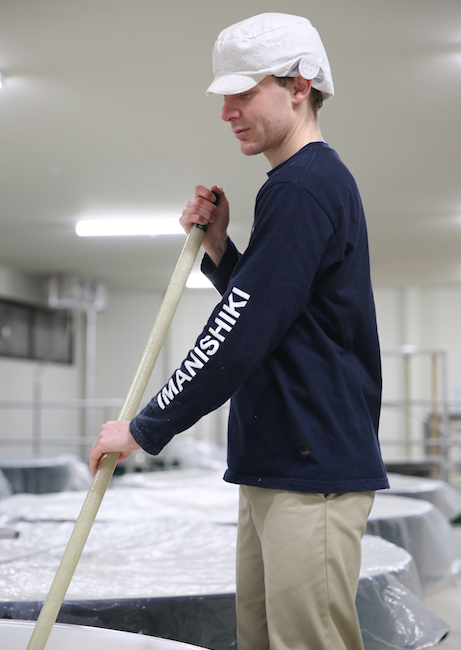
The Charm of Sake by Nigel Hay
Introduction:
Although my time in the world of sake is still just shy of two years, I’ve had the chance to talk to many people, who are passionate about this mysterious drink, discuss what it is about sake that really brought them in. The charm of sake can often become rather profound and quite complex. And for every individual, the charm and reasoning can also vary greatly. For me personally though, as someone that has two seasons of brewing sake under my belt at Yonezawa Sake Brewery in Nagano Prefecture of central Japan, I’ve found the charm of sake to be not just about the drink itself is made and the resulting taste, but also the social and culture aspect of the drink.
The drink itself:
Understandably, how the sake is made is pivotal to how the sake turns out but even the smallest change in the brewing technique can have quite the impact! Inside the making of sake you have to consider that even though the ingredients of sake are so simple, the complexity and number of factors that influence the brewing process affects how the sake develops, leading to an endless number of unique and different sakes.
Grabbing a bottle of sake and reading the label you will always see that sake consists of three ingredients; rice, koji (malted rice), and water (with brewing alcohol used in some varieties of sake as well). Despite how plain the ingredients can be regarded (and interestingly, considering that it is made with Japan’s staple food), I have found that the variety and differences between the individual ingredients in their simplest state and how the ingredients can be altered to attain certain attributes and characteristics in the final product to be quite fascinating.
In terms of how much these ingredients can be customised; for the rice, the variety of rice itself, the polishing of the rice, how the rice was washed and handled, and more. For koji, not just the differences in the state of rice used to make the koji stated in the previous sentence, but how much effort and the development and fine-tuning of the techniques used in the koji-muro in koji-making. Koji, not only regarded as the most important ingredient in sake making but also with its wider uses and importance in other fermented products, in itself is quite captivating. Lastly, the difference in water is important too! It might seem that all water is just water but depending on where the water is sourced from, its chemical composition and the nutrients it contains can vary greatly. This composition of elements affects the nutrients in the sake mash available to the rice and koji during its brewing leading in itself to different brewing strategies and different tastes. Once I was rather moved when I had the chance to listen to a sommelier talk who made comments about the “mineralliness” of the sake he was drinking during a tasting. Not just the ingredients themselves, but the ratios between these three ingredients in the sake is impactful.
The toji (head brewer) with their vast knowledge of sake brewing, can alter and adjust, even add their own unique touch, to each step of the sake making process to create their desired sake. Thecustomizability of sake and variety out there means that there is always a sake for everybody. Particularly with the designated grading of sake (Junmai Daiginjo, Junmai Ginjo Tokubetsu Junmai, the brewing-alcohol added equivalents, Futsushu etc.), it is easier for consumers to be able to understand the level of the sake out there that can be enjoyed. Admittedly, when I first tried sake many years ago I didn’t particularly enjoy it and didn’t come to appreciate sake until I was enthralled much later when I was able to try a range of different sakes.
How it is enjoyed:
In recent years sake has become a fairly global drink with sake breweries popping up all over the world. Locally in Japan, throughout history it has always been deeply rooted in Japanese culture and is the national drink of Japan (although not necessarily the most consumed). At various celebrations and festivals, both large and small, sake has always played a role. For me personally, in some ways I feel that my interest in sake came mostly from an extension of an interest in Japanese culture.
Nothing beats an outing to a local izakaya with friends. I’ve always loved the smaller izakaya with a set course of food accompanied by a variety of sakes. The custom of oshaku, where you pour one anothers drink adds a whole other level of enjoyment to the experience. At a lot of izakayas, sake is typically matched with small Japanese dishes. Since it is Japans national drink and until recent years was only majorly enjoyed in Japan, there is often a misunderstanding that sake only goes with Japanese food. There have been great improvements in dismissing this misconception thanks to education and the growing popularity of sake around the world. One thing I’ve really enjoyed with sake is trying it with a platter of assorted finger food and seeing what sake goes well with what snack.
Although I think it can be considered to be somewhat of a cultural novelty during one’s first glimpse into the world of sake, trying different sake at varying temperatures is an adventure in itself! Trying a new sake chilled, enjoying it, then wondering how the aromas and taste change if warmed to a higher temperature (and even just room temperature) can lead to a lot of experimentation and fun.
I would still consider myself somewhat of a novice when it comes to finer points and world of sake in general, but I’ve found that the charm of sake for me only goes deeper with every bottle.




